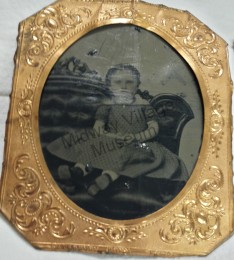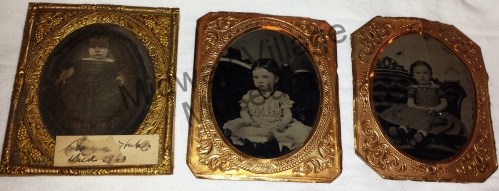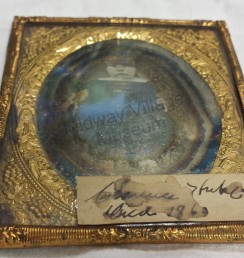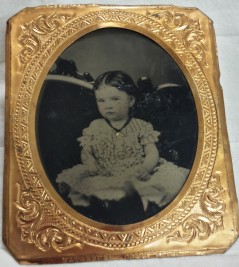What some may not realize about the job of a curator is that a lot of their time is spent problem solving. The work that goes into caring for museum collections can sometimes involve trouble shooting issues or finding the best support for a fragile item. It can also involve good old fashioned detective work. Digging into the story of an object is just as exciting as the object itself, and lends depth and context to the artifact.
These sorts of projects can also take quite a bit of time. If you have ever done genealogical research, you know what I mean! Needing to dig into the story was recently the case with some items I was working with in the collection here at Midway Village Museum, and I will share with you the exciting stories I uncovered.
The Items in Question:
The items themselves are small, the largest measuring 2 ¾” wide by 3 ¼” high. Two are tintypes and one is a daguerreotype. All three have gold colored metal frames. There are small paper notes pasted to them, reading as follows: ‘Clarence Huke. Died 1860.’ ‘Emma Huke.’ ‘Fanny Huke.’ This was all the information there was to work with. The items came in as a part of a large bequest from the estate of Edna May Taylor in 2012, and, not being able to find an initial connection to the family or to Rockford, I kept the small images with some other items from the estate that we were working through identifying.
With the vigorous pace of museum work, tackling exhibit projects along with collections care and cataloguing, some projects are saved for later. The bequest collection included nearly 1,000 items accepted for the permanent collection, which took over 2 years to fully catalogue, a process that involves giving each item a number, and then entering the record of that item, with information on its history, dimensions, and condition, into our collections database. While doing some reorganizing last month, I ran across these mystery objects once again. These 3 little gold frames now had names on the back that seemed more familiar. For whatever reason now, the last name ‘Huke’ struck a chord with me.
I slowly worked out why ‘Huke’ rang a bell now and had not before. In 2013 the museum received a large collection of Civil War letters from the Bittle family. They currently are part of a transcription project that I have been working on with the help of some local Civil War enthusiasts (to see the letters, go here: http://mvm-collections.com/projects/items/browse ). Once in a great while I have time to work on transcribing one of the letters myself, which was the case recently. One of the letters, written from Charles Sealy to his sister Mary, mentions a ‘Mate Huke.’ With the match of the last name to those small images, and knowing that the Sealy brothers often called their sister Mary ‘Mate’, I started looking for a Mary Huke. Using online databases, city directories, and other collections resources here at the museum, I followed the trail. Not only did I figure out why the images were in the contents of the Taylor estate, but I found their connection to Rockford, and built a sketch of their life stories, basically hitting the historical jackpot!
The Hunt:
I found the Huke family living in Rockford in the 1870 Federal Census. Digging further, I found that the family originally lived in Geneva, New York. George W. Huke (b. October, c. 1830, d. 4/3/1903) was born near Barnaby in England. He immigrated to the U.S. in 1850 and worked early on as a carpenter and a builder, according to Federal Census records. His occupation was noted in those records as a ‘commercial traveler,’ and his obituary states that he was superintendent of the American Heating and Ventilating Company, and traveled around the country supervising installation of the company’s products. He was a charter member of the Christian Union Church and was active in the church’s different groups (Rockford Morning Star, 4/4/1903). His wife, Mary H. Jones Huke (b. c. 1830, d. 4/17/1897) was also born in England, and she and George married in Geneva, N.Y. The family moved to Rockford between 1866 and 1867. In the 1870 Census the family was living in the 4th Ward in Rockford. Mary worked keeping house, and also was a charter member of the Christian Union Church. She died in Winnebago County in 1897.
Their son Clarence Huke (b. 1855, d. 1860) (also spelled Clarance) was born in 1855 in Geneva, NY, and it is confirmed by the 1860 New York Census, where his name does not appear, that he died around the age of 5. While his daguerreotype is beginning to degrade, you can still see that he was very young at the time, still in a plaid patterned dress, as was the fashion for both young girls and boys during that time.
Daughter Fanny W. Huke (b. 3/28/1858, d. 2/12/1923) (also spelled Fannie) was born in 1858 in Geneva, NY. Her tintype shows her very young, hair parted down the middle, with colorized rosy cheeks, sitting on a sofa. She’s wearing a light colored dress with dots on it and a small necklace with a pendant colored in with gold. She arrived in Rockford along with her parents when she was about 8 or 9 years old.
At age 25, Fanny married Bryant Kerr (b. 3/29/1848, d. 2/17/1916) on 9/26/1883 in Winnebago County, IL. Bryant was the son of a Scottish born minister Thomas Kerr (b. 5/24/1824, d. 1/4/1904) and New York native Sarah J. Kerr (b. c. 1830, d. 1/18/1908).
Locally, the Kerr family had a large role in religious developments. Dr. Thomas Kerr immigrated to the U.S. in 1844, and studied medicine at Columbia College and Iowa State University. After practicing medicine in Elgin, IL, he entered religious studies and was ordained as a Baptist clergyman in Elgin in 1857. He moved around to different churches, and first came to Rockford June 1, 1860 and led the congregation of the First Baptist Church. He later left the area to work in Hannibal, MO, returning to First Baptist Church in Rockford in 1869. He broke with that church after, as his obituary puts it, “…Dr. Kerr outgrew his environments and began to preach a broader, richer and sweeter gospel to which some of his parishoners took exception and brought charges against him, whereupon he tendered his resignation Aug. 28, 1870” (Rockford Morning Star, 1/5/1904). He was later deposed from the ministry in October and Dr. Kerr, along with 48 other church members, were excluded from the church. Kerr was determined to leave Rockford, but was convinced to stay by some of his fellow excluded persons, and after raising monies and gaining support, the Church of the Christian Union (later, Christian Union Church), was formed, opening in October of 1870. Kerr remained the only active pastor in the church until 1901.
Sarah and Thomas Kerr were married on 10/1/1845. Sarah kept house, and was noted in her obituary as being “unassuming,” and well-liked. She was also respected in the community for her dedication to her husband and home. “She was possessed of a quiet and sweet disposition that endeared her to all…” (Morning Star, 1/19/1908) She fell ill in the year before her death, prompting her daughter Alice J. Kerr Dick to come home from Kentucky in the fall of 1907 to assist her mother.
Their son Bryant was born in 1848 in Big Foot Prairie, IL, and worked as a dentist. He and Fanny do not, according to the Federal Census records, appear to have had children, and the 1914 Rockford City Directory lists his dental offices at 403-404 Masonic Temple, with he and wife Fanny living at 209 N. Church Street.
Tragically, Bryant committed suicide in 1916 after a burst blood vessel in his eye was affecting his vision. Though he kept it quiet from his family, Bryant had suffered the burst blood vessel in December of the previous year and progressively noticed that it was a detriment to his dental practice. He shot himself in his dental office after writing notes to his wife, his fellow dentist Dr. J. E. Allaben, directing him to all keys and combinations in the dental office, and a third message left on the mirror that read ‘Don’t take me home, Call for Burpee’, referring to Harry B. Burpee, who ran Burpee undertaking parlors at 108-110 West State Street (Daily Register Gazette, 2/18/1916 & Rockford Republic, 12/11/1916).
Fanny was a member of Mendelssohn Club, the Woman’s Club, and the Church of the Christian Union. Fanny died 2/12/1923 in Rockford at the age of 64 after suffering from, what her obituary notes as ‘anemia’ for many years and is buried in Greenwood Cemetery.
The tintype of Emma Huke (b. 3/9/1860, d. 12/8/1925) shows her sitting on a sofa, wearing a polka-dotted dress, darker in color, with boots. The small necklace has a portion of it colorized with gold, like the tintype of her sister Fanny, and she has similarly colored in rosy cheeks. Emma was the youngest Huke child and would have traveled to Rockford with her family at age 6 or 7.
Emma was a part of the Christian Union Society, and is mentioned in the paper often for her trips to visit friends in New York (Rockford Weekly Gazette, 6/27/1883), and also in a notice that she left an expensive shawl at the opera in 1884 (Daily Gazette, 10/1/1884). It appears that Emma never married, but is involved in many of the popular events in town. In 1885 she attended the Annual Reception of the Knights Templar, and is noted as wearing “…pink satin, pink nuns’ veiling, trimmed profusely with lace, ostrich tips…” (Daily Gazette, 1/30/1885). When the 1900 Federal Census was taken, she was living with her sister Fanny, brother-in-law Bryant, and father George. By 1920, she was living as a boarder on Rockton Avenue along with a widow and the widow’s daughter. She died 12/8/1925 at age 65 in Rockford, and is buried in Greenwood Cemetery.
So what does all this mean?
So, what do these people’s stories have to do with the Taylor Estate?
The Huke family and the Sealy families are cousins!
Mary Sealy Woodward (wife of Woodward Governor founder Amos W. Woodward) is cousin to the Huke girls, as was Mary’s daughter Minnie Woodward Taylor. George W. Taylor, who was Edna May Taylor’s husband, was the son of Minnie Woodward Taylor and thus grandson of Mary and Amos. Additionally, Minnie Woodward Taylor was the unfortunate finder of Bryant Kerr’s body, which was reported in hi obituary. Minnie went to his dental offices after Fanny expressed concern to her cousin that Bryant was not answering her phone calls. The small images are a connector between 3 prominent local families and their stories of success, tragedy, and life in Rockford.
With great resources, and a bit of time and determination much can come to light! Having gone from nothing to having a sketch of the lives of these three individuals and their parents is part of the work that curators like myself love to do, and do not always have the time to do. Researching the Huke family was a rare treat, and can be counted as another mystery solved.





This story brings those three little frames to life after so many years. It was great detective work.
Wonderful work.
This so cool! This is my family! – im a Huke!
Wonderful!